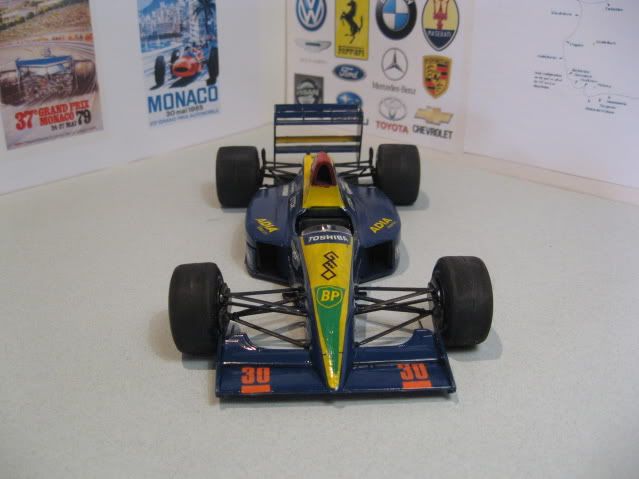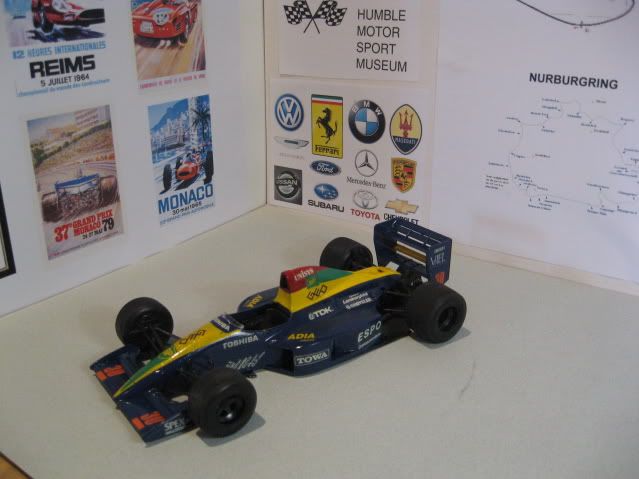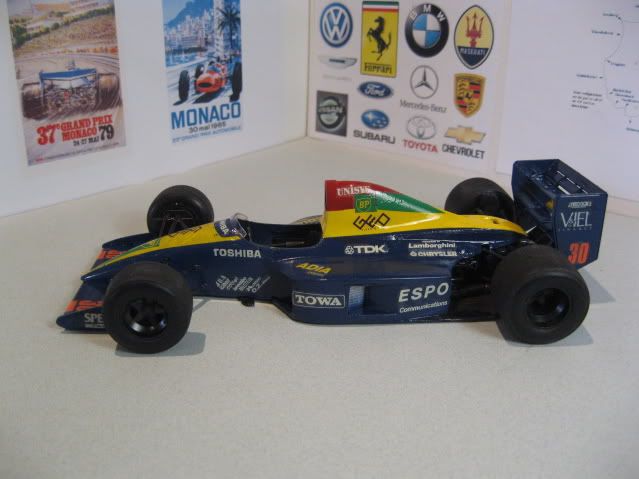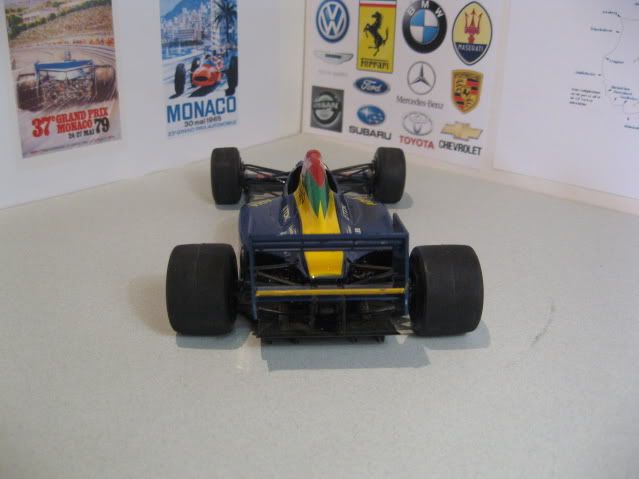F1 Cars:
BRABHAM BT33
When the Formula 1 changed to three litre engines in 1966 many believed it would favour Ferrari with their vast experience with V12 engines of that displacement. Surprisingly they struggled and so did the other top runners of the previous seasons BRM and Lotus. This gave the edge to Brabham, who fielded a relatively simple spaceframe car powered by the 'underpowered' Repco V8 engine. Nevertheless Jack Brabham took the title in 1966 and Dennis Hulme repeated that feat in 1967. By then the other teams and particularly the engine manufacturers had caught up and in 1968 the Repco engine proved to be the weak link. A switch to Cosworth power for 1969 brought the team right back to the front of the grid, despite fielding what was basically an evolution of a four year old car.
There was no room for further evolution as rule changes left the existing Brabham designs obsolete at the end of the year. The now mandatory enclosed fuel cells required a sheet aluminium chassis, although Brabham, like Ferrari, did not develop a full monocoque car. Designer Ron Tauranac did not move away from the familiar spaceframe just yet by using a tubular structure as basis for the 'semi-monocoque' of the new BT33. Brabham again opted for Cosworth power and the chassis was designed for the V8 engine to be used fully stressed. The body followed familiar Brabham lines with an easily recognisable nose, which housed the radiator and was flanked by two small wings.
Triple World Champion Jack Brabham was not surprisingly the chief driver, while Rolf Stommelen piloted the second Brabham. The first GP of the decade at Kyalami South Africa must have felt like a fresh start with many brand new cars. Brabham clearly had done their homework best over the winter as Jack Brabham converted a front row starting position into victory. It looked like 1966 all over again, but the glory was short lived as driver errors and mechanical failure struck the team throughout the season. What should have been a great farewell for 'Old Jack' ended in bitter disappointment. Probably most telling of the situation was Sir Jack's desperate attempt to win the Monaco Grand Prix, which saw him miss his braking point, handing the win to Jochen Rindt. The win in South Africa remained the team's only victory. Jack finished fifth in the driver's table and Brabham fourth in the constructor's.
Today the 1970 season is considered a missed opportunity for Jack Brabham and the BT33. A case of the famous could have or possibly should have been. The car shown here was raced by Brabham to second in the 1970 British GP.


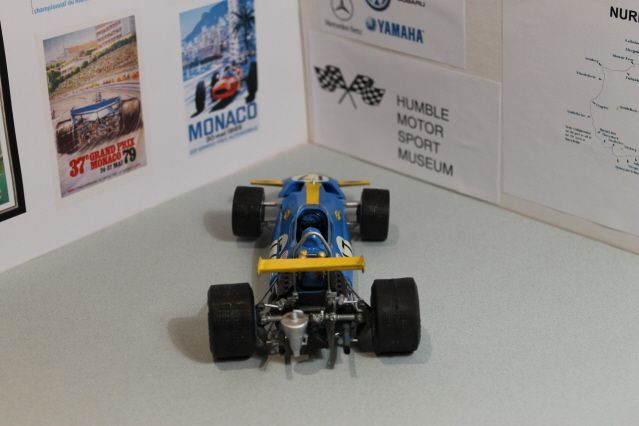
MCLAREN M7A
The McLaren M7A and its B, C and D variants are F1 racing cars, designed by Robin Herd and Gordon Coppuck, and built by McLaren. After limited success with the Formula Two-based M4A, and unreliability of the BRM-powered M5A, the McLaren team introduced the all-new M7A at the beginning of the European rounds of the 1968 Formula One season. With this car Bruce McLaren's Grand Prix team was finally a consistent front-runner, recording the team's first victory, and making Bruce McLaren only the second-ever Grand Prix driver to win a race in a car of his own construction, at the 1968 Belgian Grand Prix.
The M7's chassis was a full aluminium-sheet monocoque, with a Ford-Cosworth DFV engine and Hewland DG300 gearbox. The M7D version also used Alfa Romeo's naturally-aspirated 3 litre V8 engine in 1970. The DFV was a stressed chassis member, with suspension components mounted directly to the engine block. The front suspension consisted of lower wishbones, upper rocking arms, and outboard-mounted coil spring and damper units. The rear suspension was handled by double wishbones and coil springs. Wheelbase measured 7 feet 11 inches (2,410 mm), with front track 4 feet 9 inches (1,450 mm), and rear track at 4 feet 5.4 inches (1,356 mm).
The works cars were painted a distinctive papaya-hue; it was not a national racing colour, however, the colour would continue to be used on works McLaren cars until Yardley sponsorship was obtained in 1972. In the late 1990s, McLaren International adopted the papaya colour for McLaren racing cars seen during pre-season testing, before official sponsor layouts and designs are publicly announced. Aside from many privateer teams to equip themselves with M7 McLarens, the cars were also run by Dan Gurney's Anglo American Racers, as a reserve chassis to their own Eagle-Weslake cars. The car here was drive by Bruce McLaren to 5th place in the 1969 South African GP.
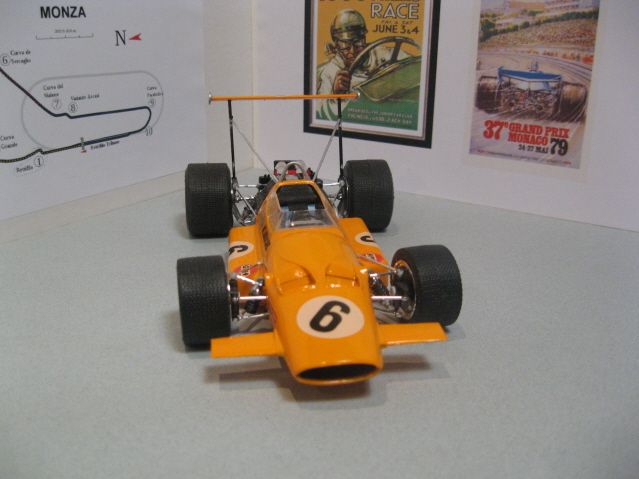
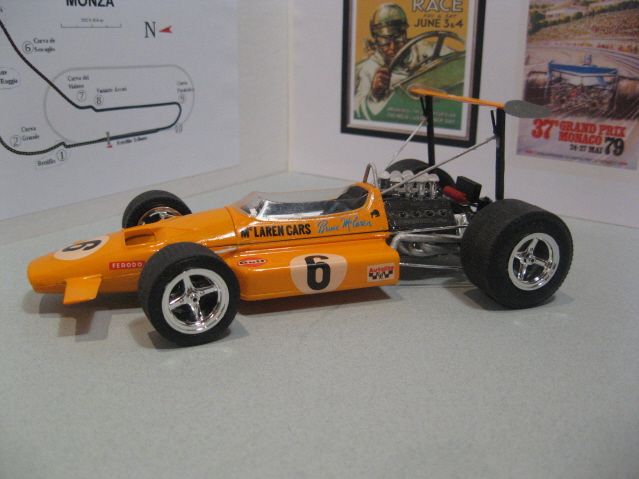

MCLAREN MP4/12
The McLaren MP4/12 was the car with which the McLaren F1 team used to compete in the1997 F1 season. It was driven by Mika Hakkinen (his car shown here) and David Coulthard. The car was a totally new machine with engines supplied by Mercedes Benz for the third year of the Anglo-German alliance. Testing was carried out with the cars painted in the traditional McLaren orange, before a striking new silver livery was launched to celebrate the team's new sponsorship deal with West. This replaced the team's 23-year association with M@r1b0r0.
The car proved extremely promising and could have won at least seven races during the course of the season, but reliability proved troublesome, in particular that of the engine. This proved frustrating, especially after Coulthard won the first race of the season in Australia, McLaren's first win since losing Ayrton Senna. The situation was exacerbated by Häkkinen retiring from three further races whilst in the lead - all from engine failures - including at the Nurburgring, where the team lost a comfortable one-two finish when both cars retired with identical failures within a lap of each other. Coulthard also lost a certain victory - at Montreal , with a clutch problem after a precautionary pitstop just a few laps before the race prematurely ended. However, Coulthard did manage to win at Monza.
During the season, a photographer noticed that the rear brakes of the McLarens were glowing red in an acceleration zone of the track. The magazine discovered through photos of the inside of the cockpit, that McLaren had installed a second brake pedal, selectable by the driver to act on one of the rear wheels. This allowed the driver to eliminate understeer and reduce wheel spin when exiting slow corners, dubbed "brake steer". Ferrari's protestations to the FIA led to the system being banned the following season at the 1998 Brazilian GP.
The team finally claimed the reward of a one-two finish at the season finale after the collision between Michael Schumacher and Jacques Villeneuve although it was a contentious finish with many nodding to the fact that Patrick Head of Williams and Ron Dennis of McLaren had negotiations where Villeneuve would give up the lead if the McLarens made sure to steer clear from the troubled Williams. Regardless, this was Häkkinen's first win in F1 and was much celebrated by the F1 world that had been tipping him to win since he first out-qualified Senna at Portugal in 1993. The win set him up with a good base to start his 1998 campaign, which he was able to win after a season-long battle with Michael Schumacher. The team eventually finished fourth in the Constructors' Championship, with 63 points.



BENETTON B194
The Benetton B194 was designed by Rory Byrne for the 1994 F1 season. The car was closely based on the previous Benetton B192/3 and powered by a Ford Zetec-RV8 engine (produced by Cosworth but badged as a Ford). The electronic driver aids that had had such an effect on F1 over the previous seasons were banned, so the car had to be redesigned with the new rules in mind. The B194 was a light and nimble car that handled well and was most competitive on twisty tracks unlike the early Williams FW16 which proved difficult to drive thanks to Williams' dependence on electronic driving aids in the previous season. Michael Schumacher's B194 remained the most competitive car until Williams introduced a B-spec car at the German Grand Prix.
The car was very competitive in the hands of Michael Schumacher, for which the B194 was specifically designed to suit his driving style. Schumacher won six of the first seven races of the season after his main rival; Ayrton Senna was tragically killed at the San Marino Grand Prix. Other teams suspected the B194 was not legal, due to the high competitiveness of such a comparatively underpowered car. The FIA launched an investigation and indeed banned software was discovered in the cars' onboard computer systems, but the governing body could not prove the systems had been used so the complaints were dropped. Schumacher himself was subject to controversy, after being disqualified from the British Grand Prix and then the Belgian Grand Prix which allowed
Damon Hill to cut into the German's points lead and as they came to the final race in Australia, Hill and Schumacher were separated by one point. Schumacher commented years later that the B194 was actually quite a handful to drive, being twitchy at the rear end.
Schumacher had three teammates— JJ Lehto, Jos Verstappen and Johnny Herbert during the course of the season. All found the B194 difficult to drive; Verstappen said in 1996 "I must have a little the same driving style as Johnny because he said basically the same things about that car that I did and seems to have had the same feelings. It was a very difficult car. You could not feel the limit and so you were pushing and pushing and then suddenly it would have oversteer. Normally when you get oversteer you can control it but the Benetton would go very suddenly and so you ended up having a spin. I had big problems with that car."
A contentious collision between Schumacher and Damon Hill (Williams) ended the 1994 drivers' title in Schumacher's favour, and the B194 was retired at the end of the season with eight wins and second place in the constructors' championship. One of Schumacher’s cars is on display here.


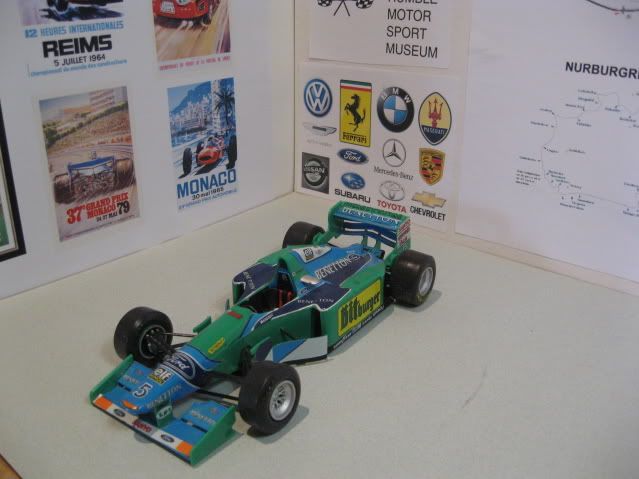

JORDAN 197
The Jordan 197 was the car with which the Jordan Formula One team used to compete in the 1997 Formula One season. It was driven by Ralf Schumacher and Giancarlo Fisichella, who were both in their first season with the team. Ralf was a complete rookie to F1, and Fisichella had only a part-season with Minardi behind him. It was seen as a gamble on the part of Eddie Jordan to recruit two young, inexperienced drivers to replace
Rubens Barrichello and Martin Brundle.
After a disappointing season in 1996, the team seemed revitalised for 1997. The car gave Jordan the chance to seriously challenge the "Big Four" teams of that time – Williams, Ferrari, Benetton and McLaren. After a couple of races to get going, Schumacher and Fisichella scored points at almost every race (apart from a barren spell at the end of the year) and took three podium finishes. Fisichella was particularly impressive, and there was a behind-the-scenes battle for his services in 1998 between Jordan and Benetton. The only downside to the season was the failure to score the team's elusive first win in F1.
The car was also notable for its distinctive bright yellow livery, as title sponsor Benson & Hedges chose to change the colour from gold. The cars also had a snake painted on either side of the nosecone, a forked tongue that extended back around the sides of the driver's cockpit and numerous scale effects on other parts to the car. When Grands Prix were held in tobacco advertising, the cars were labelled "Bitten & Hisses" or "Ssssschuey"/"Fisssssssi" instead of "Benson & Hedges". The team eventually finished fifth in the Constructors' Championship, with 33 points - the highest number of points in the team's history thus far. Fisichella’s car is displayed here.
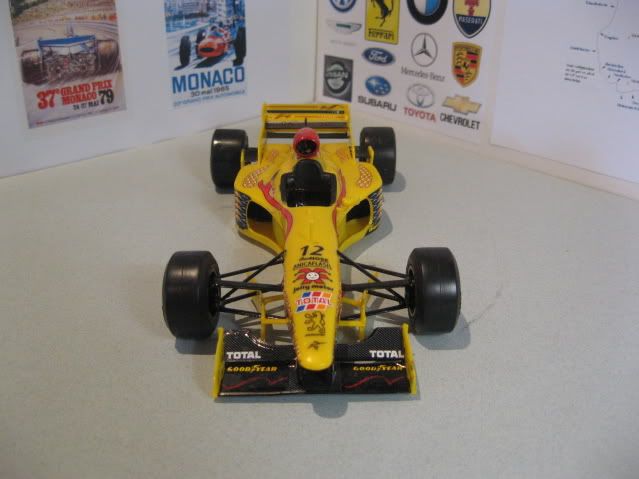
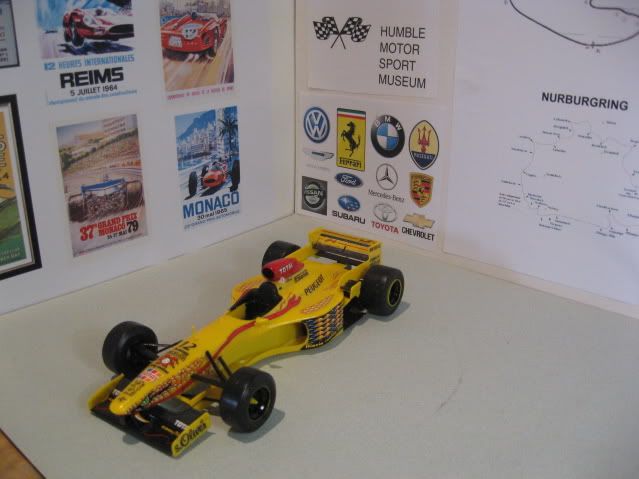


LARROUSSE LC90
Larrousse Formula One was a motorsports racing team founded in 1987 by Didier Calmels and former racer Gérard Larrousse, originally under the name Larrousse & Calmels. It was renamed Larrousse after the departure of Calmels for legal reasons. The team competed in Formula One from 1987 to 1994 before succumbing to financial problems, scoring a best finish of third at the 1990 Japanese Grand Prix with the LC90 displayed here.
Larrousse & Calmels commissioned a car from Lola, and the result was the LC87, a car designed by Eric Broadley and Ralph Bellamy. The chassis was powered by a Cosworth
DFZ V8 engine, and was entered in the undersubscribed normally-aspirated class.
The team started out with just one car for Philippe Alliot, with Yannick Dalmas joining the team in a second car the end of the year. By that time they had agreed to a three-year deal with Lola and Chris Murphy was recruited from Zakspeed to help Bellamy. The team then did a deal to run Lamborghini V12 engines in 1989. At the end of the year, Larrousse sold 50% of his shares to the Japanese Espo Corporation, and Aguri Suzuki
was hired to partner Bernard for the 1990 season.
1990 was Larrousse's best season, with Suzuki scoring the team's first podium at the Japanese GP (using the car on display here) and the team finishing sixth in the Constructors' Championship. Then things began to unravel when Lamborghini announced it was switching to Ligier. Of greater concern was the FIA considering taking away Larrousse's points because of an alleged "false declaration" about the design of the chassis. It transpired the team had made an honest mistake by registering the car as manufactured by them, when in fact it was designed and built by Lola in England. Although the team officially lost their points from 1990, the team kept the travel benefits and prize money associated with their championship finish and did not have to take part in pre-qualifying.
